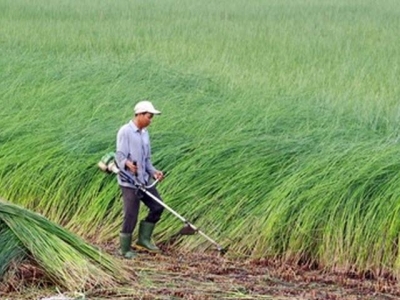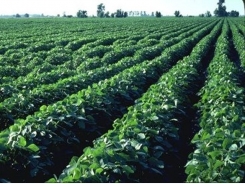Mekong Delta farmers profit from sedge boom

Farmers in Vĩnh Long Province have brought in a good harvest of lác and are earning big profits. - Photo baovinhlong
Ho Chi Minh City — Lác farmers in Vĩnh Long Province’s Vũng Liêm District are enjoying a bumper harvest and high prices.
Lác, a species of sedge used to make mats and other handicraft products, has a yield of 10-15 tonnes per hectare in the district, up a tonne from previous crops.
Traders are buying it at VNĐ15,000 – 18,000 a kilogramme, VNĐ 1,500 – 2,000 higher than during the last crop.
Nguyễn Kim Ba, who has 2,000sq.m of the sedge in Trung Thành Đông Commune, said there is more sunlight this time, creating better conditions for the plant.
As a result, the quality of the lác is also high and traders are keen to buy them, he said.
He has earned a profit of VNĐ10 million (US$440) this time, he said.
Nguyễn Văn Tám, a local trader, said the price of lác is high because supply cannot meet demand.
He buys one to two tonnes daily and sells to mat making villages in other provinces like Tiền Giang and Đồng Tháp.
More than 1,000 households in Trung Thành Đông Commune have had good incomes after switching to grow lác on their infertile paddy fields.
Lác provides four to five harvests a year and is easy to grow.
The Cửu Long (Mekong) Delta province of Vĩnh Long has around 306ha under the crop, mostly in Trung Thành Đông and Thanh Bình communes.
Trung Thành Đông, the district’s largest lác planting area, has 227ha.
Besides providing stable incomes to farmers, the sedge also creates jobs for people who have to harvest, split, dry and spin the plant and weave mats, according to the district Agriculture and Rural Development Bureau.
Huỳnh Văn Vũ, chairman of the Trung Thành Đông People’s Committee, told Thanh Niên (Young People) newspaper that farmers in the commune’s Đại Hòa, Đại Nghĩa and Phú Nông hamlets have converted all infertile paddies into lác fields.
“The profit from lác is six times that from rice.”
The commune has nearly 3,000 people, or 70 per cent of its workforce, whose jobs are related to the crop.
Labourers earn VNĐ60,000 -70,000 ($2.6 - 3) a day from harvesting, splitting, drying, and spinning it.
The district will encourage farmers to grow lác in zoned areas and saltwater-contaminated areas, according to the bureau.
Authorities would continue to identify buyer companies to guarantee outlets for products made from lác, it added.
Related news
Tools

Phối trộn thức ăn chăn nuôi

Pha dung dịch thủy canh

Định mức cho tôm ăn

Phối trộn phân bón NPK

Xác định tỷ lệ tôm sống

Chuyển đổi đơn vị phân bón

Xác định công suất sục khí

Chuyển đổi đơn vị tôm

Tính diện tích nhà kính

Tính thể tích ao



 Yen The develops hill chicken under value chain
Yen The develops hill chicken under value chain  “Sigh” of the cashew industry
“Sigh” of the cashew industry